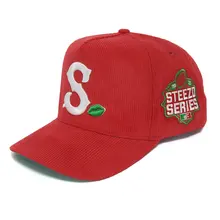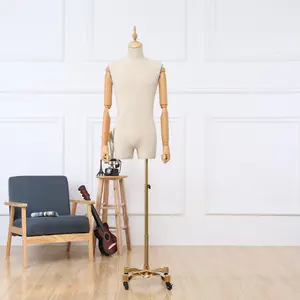The dressmaker dummy is an essential tool for fashion designers, tailors, and dressmakers. It serves as a three-dimensional model for the creation, display, and alteration of garments. The dressmaker dummy, also known as a dress form, allows for precise fitting and draping, which is critical in the high-stakes world of fashion design and garment production.
Types and Characteristics of Dressmaker Dummies
Within the category of dressmaker dummies, there are several types, each with unique characteristics. The adjustable dress form is prized for its versatility, allowing for changes in size to fit various body shapes. Professional dress forms are designed to mirror human anatomy closely, providing a realistic drape for garment construction. Vintage dress forms and antique dress forms are sought after for their aesthetic appeal and are often used in boutique window displays. For male garments, a male dress form is essential due to its specific body proportions. Each type caters to different needs within the garment creation and display process, from the high-volume production of a fashion house to the bespoke creations of a custom tailor.
Structure and Operation of Dressmaker Dummies
The structure of a dressmaker dummy is designed to replicate the human form accurately. A typical dress form mannequin includes a torso, which is the main part where garments are draped. Some models include legs and arms, which are crucial for fitting trousers and sleeves. The base is often a sturdy structure, like a glass base, which provides stability. Many forms also come with adjustable stands that allow the height to be modified. The operation of these components together enables the designer to simulate how a garment will look and fit on an actual human body.
Materials and Their Properties
The materials used in dressmaker dummies are chosen for their durability and their ability to mimic the human body's contours. PE and PP are lightweight and cost-effective, making them suitable for forms that need to be moved frequently. FRP and ABS offer more strength and can withstand the rigors of heavy use in a busy design studio. Linen, a traditional covering, is favored for its durability and the ease with which pins can be used. The eco-friendly and durable nature of these materials ensures that the dress form for sewing is not only practical but also sustainable.
Business Usages and Applications
The dressmaker dummy finds its place in various business settings, from fashion design studios to retail store displays. In haute couture, precision is paramount, and the seamstress mannequin adjustable forms are indispensable for creating exquisite, well-fitting garments. Retail stores use mannequins for window displays to attract customers, showcasing the latest trends and how clothes fit on a human figure. In educational settings, these dummies are tools for teaching students the art of garment construction and design.
Functions and Tasks
A dressmaker dummy is designed to perform specific tasks in garment production. It serves as a stand-in for a human body during the design, fitting, and alteration stages. An adjustable dress form for sewing allows for multiple sizes to be accommodated, making it a multifunctional tool for designers who cater to a diverse clientele. The ability to pin fabric directly onto the dummy is another critical function, enabling designers to experiment with drapes and fits before the final sewing.
Features and Unique Selling Points
The distinct features of a dressmaker dummy include its adjustability, durability, and lifelike proportions. An adjustable dressmakers dummy can be modified to represent different body sizes, which is a unique selling point for businesses that produce custom-fit apparel. The durability of materials like FRP ensures that the dummy can withstand the wear and tear of frequent use. Lifelike proportions are crucial for accurate garment fitting, setting professional-grade dummies apart from decorative or display-only models.
Benefits and Positive Outcomes
The benefits of using a dressmaker dummy are manifold. For designers, it provides a clear and accurate canvas for creating garments. Retailers benefit from the appealing display of clothing that a mannequin dress form provides, which can enhance sales. For tailors, the dummy is a time-saver, allowing for alterations and adjustments to be made with ease. The end-user, or wearer, benefits from clothing that fits better and is more flattering, as it has been tailored to a form that closely resembles a real human body.
How to Use, Choose, Clean, Maintain, and Install
Effective operation of a dressmaker dummy involves knowing how to adjust it to the desired size and how to pin garments correctly. Choosing the right model requires an understanding of the specific needs of your business, whether it's for display or garment creation. Cleaning a dummy is straightforward but essential for maintaining a professional appearance, usually involving a simple wipe-down with a damp cloth. Maintenance might include tightening screws and checking the stand for stability. Installation is typically minimal, with most dummies coming pre-assembled or requiring only the base to be attached.
Target Audience and Meeting Needs
The target audience for dressmaker dummies varies from fashion students to professional designers and retail stores. Each product, such as the sewing mannequin adjustable or the vintage dress form, is tailored to meet the specific needs and preferences of these groups. For instance, a fashion student might require an affordable, adjustable form, while a high-end designer might prefer a professional form with detailed body proportions.
How does an adjustable dress form enhance the design process?
An adjustable dress form enhances the design process by allowing designers to simulate various body shapes and sizes, making it easier to create garments that fit a wider audience. The adjustability feature is particularly useful for accommodating the unique measurements of individual clients, ensuring a custom fit.
What materials are used in high-quality dressmaker dummies?
High-quality dressmaker dummies are typically made from materials like FRP or ABS for durability. Linen is often used to cover these forms, providing a pinnable surface that can withstand repeated use. The choice of high-quality materials ensures that the dress form mannequin remains stable and functional over time.
Why is a professional dress form preferred in the fashion industry?
A professional dress form is preferred in the fashion industry for its accuracy in dimensions and proportions, which closely mimic the human body. This precision is crucial for creating well-fitting garments. Additionally, professional forms often have features that cater to specific garment types, such as collapsible shoulders or the inclusion of legs and arms.










































 浙公网安备 33010002000092号
浙公网安备 33010002000092号 浙B2-20120091-4
浙B2-20120091-4